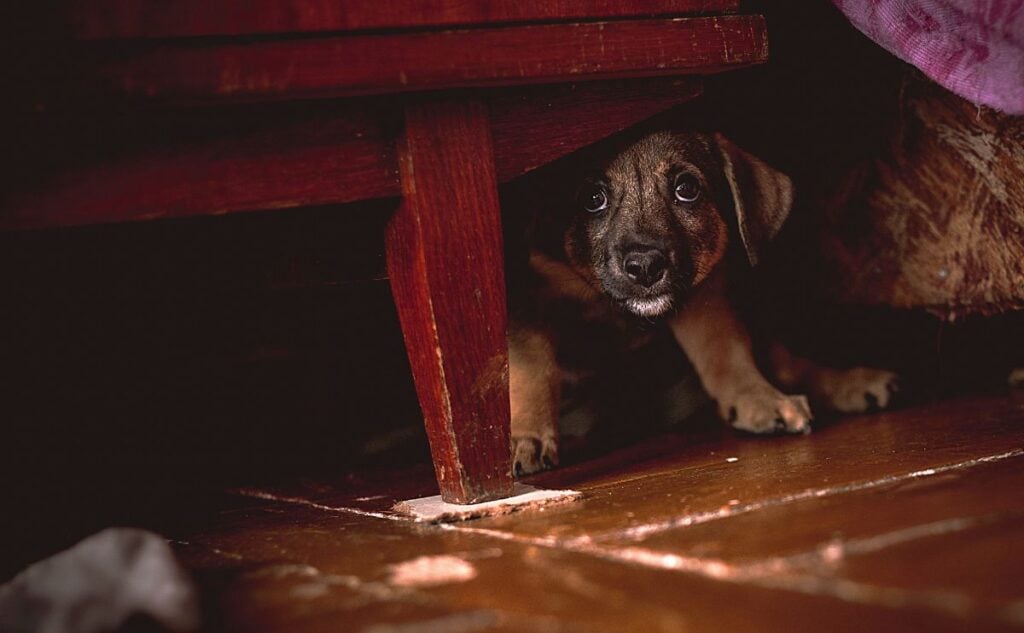Whenever you buy by way of hyperlinks on our web site, we might earn a fee. Right here’s the way it works.

Bringing a brand new pet into your house is an thrilling and rewarding expertise. However as they develop, you might discover sudden adjustments of their conduct. A as soon as assured and curious pet may out of the blue turn out to be hesitant, startled, or afraid of issues they have been beforehand snug with. This shift may be shocking, however it’s a regular a part of growth often called a pet worry interval.
Whereas worry durations in canines may be difficult for each puppies and their house owners, understanding them will help you present the appropriate help and reassurance to make sure your pup grows right into a assured, well-adjusted companion. I discover what they’re, the 2 widespread pet worry durations, learn how to deal with them, and different ideas to assist your pet navigate this seemingly robust time.
What Are Pet Concern Intervals?
Pet worry durations are phases in a pet’s growth once they can turn out to be particularly delicate or frightened by new experiences, folks, or environments. These durations are a traditional a part of a pet’s development and sometimes happen within the first yr of life, though the precise timing can differ between particular person puppies. Throughout these phases, a pet could seem extra skittish, anxious, or reactive to issues that wouldn’t usually trouble them. Listed below are the widespread indicators of pet worry phases:
- Sudden worry of individuals, objects, or environments they have been beforehand snug with
- Cowering, hiding, or making an attempt to keep away from sure conditions
- Elevated barking, growling, or reactivity in the direction of perceived threats
- Hesitation or refusal to stroll in particular areas
- In search of reassurance from their proprietor greater than standard
Throughout pet worry durations, they could react strongly to unfamiliar stimuli, resembling loud noises, new folks, and even novel environments. These episodes of worry may be triggered by issues so simple as a sudden change of their routine, a brand new object showing in the home, or an sudden loud sound like a door slamming or thunder.
Whereas this conduct may be alarming for pet house owners, it’s a traditional developmental section. The rationale for these worry durations is that puppies are nonetheless studying learn how to navigate the world round them, and their brains are extremely impressionable throughout this time.
2 Frequent Pet Concern Levels

Puppies undergo numerous developmental phases, and worry durations are a pure a part of their development. These are the worry phases when puppies turn out to be extra delicate to their environment, reacting with worry or hesitation to issues they may have beforehand been snug with. Understanding these important phases can make it easier to help your pet with endurance and reassurance, making certain they develop into assured and well-adjusted grownup canines.
1. First Concern Interval In Canines: 8-11 Weeks
The early worry interval sometimes happens throughout the latter a part of a pet’s important socialization window, which spans from about 3 to 14 weeks. By the point they attain 8 to 11 weeks, puppies are starting to develop their very own sense of the world round them, and their brains are actively absorbing data. This stage is marked by the onset of worry responses to atypical or acquainted issues, resembling new sounds, folks, or objects.
Damaging experiences throughout this era can have long-lasting results. As an illustration, if a pet is startled by a loud noise or a sudden motion, they could type a detrimental affiliation with that sound or scenario. This will result in a long-lasting worry of sure objects, conditions, and even folks. This era is significant for socialization. Throughout this time, constructive experiences and mild publicity to completely different environments, folks, and animals will help stop future fears. For instance, calmly introducing your pet to new conditions will help them construct confidence. Watch this quick video exhibiting how this pet was initially afraid of a brand new toy however rapidly turned snug with it with endurance.
2. Second Concern Interval In Canines: 6-14 Months
The second worry interval in canines sometimes happens when puppies attain adolescence, round 6 to 14 months of age. It is a time of great hormonal adjustments as they start to mature bodily and emotionally. The second worry interval usually coincides with bodily growth; the pet might really feel not sure about their place on this planet. Throughout this stage, puppies might expertise a resurgence of fearful or anxious conduct, even when they beforehand appeared well-adjusted to sure conditions.
Puppies that have been beforehand assured might out of the blue turn out to be afraid of issues they weren’t petrified of earlier than. For instance, they may turn out to be anxious about assembly new folks, encountering bigger canines, or being in unfamiliar environments. Concern of sure conditions, resembling automotive rides, strolling in public areas, or encountering different canines, might re-emerge. This will occur even when the pet has had constructive experiences with this stuff previously.
How Lengthy Do Pet Concern Intervals Final?

The length of a pet’s worry interval can differ relying on elements resembling breed, temperament, genetics, and former experiences. Usually, every worry interval lasts wherever from a number of days to a few weeks. Nonetheless, some puppies might have lingering sensitivity past this timeframe, significantly in the event that they expertise a powerful antagonistic response to one thing throughout this stage.
The primary worry interval in canines tends to be temporary, usually lasting a number of days to every week. Because it happens throughout the essential socialization window, puppies are nonetheless extremely adaptable. If dealt with accurately, they’ll rapidly overcome minor fears. The second worry interval in canines may be extra unpredictable. Some canines might undergo it rapidly (inside every week or two), whereas others may expertise fluctuations in confidence over a number of months. It usually is determined by the person canine’s maturity charge, different behavioral issues, hormonal adjustments, and environmental influences.
Why Does The Size Of A Concern Interval Range?
- Breed Variations. Some breeds mature sooner than others. Giant breeds, for instance, take longer to develop, so their second worry interval may prolong additional into adolescence.
- Particular person Sensitivity. Extra cautious or nervous puppies might take longer to work by way of their fears, particularly if they’re naturally shy.
- Previous Experiences. Puppies with principally constructive interactions with their atmosphere might rapidly transfer by way of a worry interval. Compared, these with restricted socialization or detrimental experiences might wrestle for longer.
Understanding & Coaching Via Concern Intervals
The way in which a pet reacts throughout a worry interval can differ. It’s because puppies are nonetheless constructing belief and understanding of their atmosphere. The issues they encounter at this stage can go away a long-lasting impression, which is why constructive, calm experiences are so essential. Puppies are usually extra delicate to sure stimuli throughout these worry durations as a result of their socialization and emotional growth are nonetheless within the early phases. They haven’t absolutely developed the coping mechanisms that older canines have, and their emotional responses may be far more intense.
Be conscious of the pet’s reactions and keep away from overwhelming them with an excessive amount of stimulus. That is why, particularly throughout these phases, it’s necessary to keep away from punishing fearful conduct. As an alternative, reinforcing constructive associations and providing consolation will help them overcome their anxieties and turn out to be extra resilient. Give attention to creating constructive associations with new experiences.
Turning Concern Into A Optimistic Studying Expertise

Fearful moments may be unsettling for each puppies and their house owners, however with endurance and the appropriate strategy, these conditions can turn out to be invaluable studying experiences. The way you reply to your pet’s worry can form their confidence and resilience in the long term. As an alternative of forcing them to face their fears head-on, give attention to gradual publicity, constructive reinforcement, and permitting them to maneuver at their very own tempo. Right here’s a step-by-step information to serving to your pet work by way of their fears in a wholesome manner:
1. Give Your Pet Area To Retreat
When your pet encounters one thing that frightens them, their first intuition could also be to maneuver away. Enable them to take action with out forcing them to confront the article too quickly. Giving your pet management over the scenario helps them really feel safer and prevents their worry from escalating into panic. Watch their physique language – indicators like tucked tails, pinned ears, or backing away point out discomfort. In the event that they select to watch the scary object from a distance, that’s completely okay.
2. Reward Engagement & Reassurance-In search of
As an alternative of making an attempt to consolation your pet with extreme petting or cooing, which may typically reinforce fearful conduct, give attention to rewarding calm engagement. In case your pet appears to be like on the object that scared them, supply reward and a deal with. This teaches them that going through their fears, even from a distance, results in constructive outcomes. In the event that they look at you for reassurance, reward that too – this strengthens their belief in you as a supply of security and steering.
3. Enable Your Pet To Management Their Strategy
By no means drive your pet nearer to the factor that scared them, and keep away from luring them ahead with treats. This will backfire, because it places stress on them and will enhance their anxiousness. As an alternative, let them determine if and once they need to get nearer. Reward any small indicators of curiosity, resembling wanting on the object, stepping in the direction of it, sniffing, or wagging their tail. This gradual, pressure-free strategy helps construct confidence over time.
4. Maintain Coaching Classes Brief & Optimistic
Endurance is vital when working by way of worry. In case your pet doesn’t fully overcome their worry in a single session, don’t fear – it’s fully regular. Maintain interactions temporary, enjoyable, and stress-free. Even small progress, like a hesitant sniff or a relaxed posture, is a step in the appropriate course. At all times finish on a constructive observe by rewarding your pet with coaching treats, reward, or playtime to bolster good experiences.
5. Preserve A Calm, Informal Angle In Future Classes
Canines take emotional cues from their house owners, so they could turn out to be much more anxious if you happen to make a giant deal out of their worry. As an alternative, act as if the scary object is not any huge deal and proceed to include it into on a regular basis life. Use a toy or enjoyable exercise to redirect their consideration and assist them have interaction with the article in a relaxed manner. Allow them to discover at their very own tempo and stay at a cushty distance.
Are Concern Intervals The Identical For All Breeds?

No, worry durations aren’t the identical for all breeds. Whereas all puppies undergo worry durations as a part of their growth, the depth, length, and particular triggers can differ considerably relying on breed traits, genetic predisposition, and particular person temperament. Some breeds are naturally extra assured and resilient, whereas others are extra cautious or delicate to their atmosphere. Right here’s how completely different breed teams might expertise worry durations in a different way:
Guardian & Working Breeds
Guarding breeds resembling German Shepherds, Dobermans, Rottweilers, and so forth, are bred to be alert and protecting, which may make them extra conscious of adjustments of their atmosphere. They might undergo a extra pronounced second worry interval (6–14 months) when their guarding instincts begin creating. Correct, managed socialization throughout worry durations is essential to stop reactivity or overprotective conduct in maturity.
Herding Breeds
Herding breeds resembling Border Collies, Corgis, and Australian Shepherds are extremely smart and delicate, which means they could react extra intensely to sudden adjustments or unfamiliar stimuli. As a result of they’re bred to be aware of their environment, they could develop fears of sure objects, noises, or motion patterns (e.g., bicycles, skateboards, or fast-moving folks). Concern durations might final barely longer resulting from their heightened consciousness and fast studying means.
Toy & Small Breeds
Small breeds, resembling Chihuahuas, Dachshunds, and Pomeranians, are usually extra liable to fearful conduct as they’re bodily extra susceptible. Their worry durations might seem extra intense or extended, particularly if they’re continuously uncovered to bigger canines or overwhelming environments. They might require additional endurance and gradual publicity to new experiences to assist them construct confidence.
Sporting & Retriever Breeds
Usually, social and outgoing sporting breeds like Labradors, Golden Retrievers, and Spaniels might have milder worry durations than others. Nonetheless, particular person temperament performs a major position – some could also be additional delicate to new experiences or loud noises. As a result of they’re usually desperate to please, reward-based coaching may be extremely efficient in serving to them work by way of fears.
Sighthounds & Primitive Breeds
Some breeds, particularly these with impartial natures, like Greyhounds, Basenjis, and Shiba Inus, might withdraw quite than confront their fears. They is likely to be extra reserved or aloof and wish additional endurance and mild encouragement to interact with their environment. Overexposure or forcing interactions throughout worry durations may be counterproductive for these breeds.
Most Vital Canine Concern Interval Takeaways

- Be Affected person & Don’t Panic. Maintain a relaxed and reassuring perspective, as puppies can decide up on their proprietor’s anxiousness and will turn out to be extra scared in the event that they sense misery.
- Particular person Variability. Even inside a breed, every pet is exclusive. Genetics, early socialization, and former experiences tremendously affect how worry durations manifest. Two puppies of the identical breed might react in a different way. One may breeze by way of worry durations with little difficulty, whereas one other may want additional reassurance and coaching.
Continuously Requested Questions
We perceive that pet worry durations could be a complicated and typically traumatic a part of elevating a younger canine. Each pet is completely different, and their experiences throughout these developmental phases can differ. That’s why we’re right here to assist! If you happen to don’t see your query answered in our FAQ part, I encourage you to ask us within the feedback. Your experiences and questions may assist different pet house owners going through the identical challenges. So don’t hesitate to share your considerations, and let’s navigate this important stage of puppyhood collectively!
Can A Dangerous Expertise Throughout A Concern Interval Have Lengthy-Time period Results?
Sure, detrimental experiences throughout a worry interval can result in long-term anxiousness or behavioral points. That is why managing fear-inducing conditions rigorously is crucial, making certain your pet has constructive or impartial experiences quite than traumatic ones.
Ought to I Socialise My Pet Throughout A Concern Interval?
Sure, however accomplish that gently. Proceed exposing your pet to new experiences, however at a tempo they’re snug with. Keep away from overwhelming environments and give attention to managed, constructive interactions.
Will My Pet Develop Out Of Their Fears?
Most puppies naturally transfer previous worry durations. Nonetheless, fears which might be bolstered by way of detrimental experiences or lack of publicity might persist into maturity. Constant, constructive reinforcement will help stop long-term points.
When Ought to I Search Skilled Assist For Concern Intervals In Canines?
In case your pet’s worry is excessive, persistent, or worsens over time, seek the advice of knowledgeable coach or behaviorist. Early intervention will help stop worry from turning into lasting anxiousness or aggression. We have now reviewed the finest canine coaching apps that will help you prepare your pup at any time, in addition to skilled assist from trainers resembling DIYK9.
Different Pet Should-Haves
Bringing house a brand new pet is an thrilling journey, and having the appropriate necessities can set them up for a contented, wholesome begin. A high-quality pet food regimen tailor-made to their dietary wants is essential for correct development and growth, offering important nutritional vitamins, minerals, and protein. Pet teething toys are a should to appease sore gums and forestall harmful chewing on furnishings or footwear. A pet guidelines will help make sure you don’t neglect important objects. Moreover, establishing a protected area with a pet playpen can provide your pooch a way of safety as they modify to their new house. With the appropriate provides and preparation, you’ll be able to welcome your furry buddy and assist them thrive by way of their worry durations!
Do you will have a pet going by way of canine worry durations? Maybe you’re not sure whether or not your pet goes by way of a pet worry stage and wish some recommendation. Get in contact with us within the feedback part beneath.
Why Belief Canine Journal
Emma is a loyal canine mother to Chips, her charming Dachshund, and Bonkers, her uniquely lovable Bull Terrier combine. With years of hands-on expertise as knowledgeable canine walker and sitter, Emma has cared for a whole bunch of canines and has but to fulfill a pup that hasn’t skilled canine worry durations. As a devoted canine researcher and author, she works alongside an skilled crew at Canine Journal to supply canine house owners with probably the most correct, well-researched, and up-to-date data.
